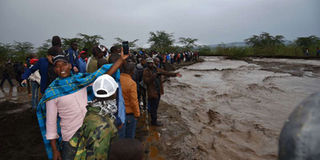Need for climate-smart county policies

Motorists watch the raging water that cut off Narok-Mai Mahiu road in Suswa area on April 15, 2018. PHOTO | GEORGE SAYAGIE | NATION MEDIA GROUP
What you need to know:
- But according to a new study conducted in all of Kenya’s 21 semi-arid counties, at least five have surpassed the 1.5-degree mark.
- The study also startlingly found that the population of cattle in the semi-arid counties has decreased by 26 per cent in the past 38 years up to 2015.
- So far, Turkana is the most affected, recording a drop of nearly 60 per cent, followed by Machakos, Garissa, Kitui and Kajiado.
The Paris Agreement on Climate Change seeks international interventions to hold the rise in the global average temperature to below 2 degrees Celsius above the pre-industrial levels and cap it at 1.5 °C.
But according to a new study conducted in all of Kenya’s 21 semi-arid counties, at least five have surpassed the 1.5-degree mark and the impact, especially on cattle survival, is devastating. Worrying projections show that the temperatures will rise even further in the coming years.
This comes just four years after a World Bank report synthesising scientific knowledge on global warming, which warned that the earth was on the path to get 4°C warmer by the end of the century — with huge implications for humanity.
DEVELOPMENT
A new study commissioned by the Canada-based International Development Research Centre (IDRC) and the United Kingdom’s Department for International Development (DFID) — through the Pathways to Resilience in Semi-arid Economies (Prise) project — show West Pokot and Elgeyo-Marakwet as the most affected counties with a temperature rise of 1.91° C in the past 50 years. Others are Turkana (1.8° C), Baringo (1.8° C), Laikipia (1.59° C) and Narok (1.75° C).
The study also startlingly found that the population of cattle in the semi-arid counties has decreased by 26 per cent in the past 38 years up to 2015.
The scientists who carried out the study attributed this to the constantly rising temperatures due to global warming and reduced or unpredictable rainfall patterns.
SCIENTISTS
So far, Turkana is the most affected, recording a drop of nearly 60 per cent, followed by Machakos, Garissa, Kitui and Kajiado, according to the study conducted by scientists from Kenya Markets Trust (KMT).
This is bad news, particularly for Turkana, Garissa and Kajiado, because livestock is the mainstay for the residents.
However, all is not lost. While the cattle population was on the decline, that of sheep and goats in the 21 counties rose by 76.3 per cent, with some, such as Laikipia and Lamu, recording a 256.6 per cent and 458 per cent increase, respectively.
WAKE UP CALL
According to the scientists, cattle can thrive if temperatures do not surpass 30°C and not below 10° C. But small animals like sheep and goats, and also camels, can tolerate warmer temperatures; hence the reason they multiplied exponentially.
These findings should be a wake-up call for all counties. They should use the data to re-evaluate what is happening in terms of rising temperatures and rainfall variations and the projections to come up with sound policies that are responsive to climate change.
One way of adapting to climate shocks and stresses will be by developing policies with clear knowledge of what the near future is likely to look like, with a focus on appropriate technologies, while being mindful of crops or livestock that are going to survive in projected climatic conditions.
TECHNOLOGIES
Kitui, Tharaka-Nithi and Embu counties are joining hands with the Pan-Africa Climate Justice Alliance (PACJA) and faith-based organisations to develop climate change policies based on experiments by farmers to identify local technologies that can aid adaptation.
Considering the Prise research findings, some counties will need to re-think and prioritise their livestock investment options to take comparative advantage of the resources they have. They could invest in slaughterhouses — for example, Laikipia and Isiolo (cattle), Marsabit (goats) and Wajir (camel, sheep and goats).
County governments must, therefore, consider such important knowledge as they develop their spatial plans.
Mr Esipisu, a freelance journalist, is the coordinator for Pan-African Media Alliance for Climate Change (PAMACC). [email protected]





